Creating an exceptional user experience (UX) is essential for any successful web design. With the internet becoming an integral part of our daily lives, users demand interfaces that are not only aesthetically pleasing but also intuitive and efficient. Here, we explore practical tips to enhance UX, ensuring that your website effectively meets user expectations.
1. Understand Your Audience
The first step in enhancing UX is understanding who your users are. Conduct thorough research to gain insights into their demographics, preferences, and behaviors. Use surveys, interviews, and analytics tools to gather data. Creating user personas based on this information can guide your design decisions, ensuring they align with users' needs.
2. Prioritize Simplicity and Clarity
Simplicity is key in web design. Overloading users with information can lead to confusion and frustration. Aim for a clean layout that emphasizes essential elements and guides users naturally through your site. Maintain clear, concise language and intuitive navigation to facilitate easy understanding and interaction.
3. Adopt a Mobile-First Approach
With the increasing reliance on mobile devices, a mobile-first design approach is crucial. Design your website for smaller screens initially, then scale up for larger devices. This ensures that core functionalities and key information translate effectively across all screen sizes, enhancing UX for all users regardless of how they access your site.
4. Optimize Loading Speed
Website speed significantly impacts UX. Slow-loading sites can lead to increased bounce rates and lost potential customers. Use tools like Google PageSpeed Insights to analyze your site's performance and identify areas for improvement. Compress images, leverage browser caching, and minimize code to optimize loading times.
5. Ensure Accessibility
Accessibility is an integral part of UX that ensures all users, including those with disabilities, can use your website effectively. Implement web accessibility standards such as providing alt text for images, using keyboard-friendly navigation, and ensuring sufficient color contrast. By making your site accessible, you not only comply with legal standards but also reach a broader audience.
6. Leverage Intuitive Navigation
Navigation is the backbone of user experience. Implement a logical and consistent structure that allows users to find information with minimal effort. Use clear labels for navigation items and a breadcrumb trail for users to track their progress. A well-designed navigation system can significantly reduce frustration and improve overall satisfaction.
7. Use Consistent Design Elements
Consistency in design fosters a seamless user experience. Maintain uniform styles for fonts, colors, and button shapes throughout your website. Consistent design elements help users familiarize themselves quickly with your site, promoting a cohesive and professional appearance.
8. Encourage User Feedback
User feedback is invaluable in honing UX. Implement feedback mechanisms such as surveys or integrated tools like chatbots. Listen to your users' suggestions, address their pain points, and adapt your design accordingly. Engaging with users in this way shows that you value their input and are committed to continuous improvement.
9. Focus on Content Layout
The way you present content impacts user engagement. Use headings, bullet points, and whitespace strategically to enhance readability. Break text into digestible sections and complement it with relevant images or videos. A thoughtfully designed content layout directs users' attention and keeps them engaged.
10. Conduct Regular Testing
UX is an ongoing process. Regularly test your website with real users to identify areas for improvement. Conduct usability tests, A/B testing, and monitor user behavior through analytics. These insights will guide iterations, ensuring your site continues to meet user needs and adapt to evolving trends.
By following these tips and prioritizing user experience in your web design, you can create a site that not only attracts but retains users. A well-designed UX is a powerful tool that enhances customer satisfaction, builds brand loyalty, and ultimately contributes to achieving your business objectives.
